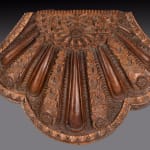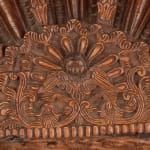Herb Box (Hierbera), circa 1770
Cast and chased wood and iron
Further images
Coca boxes or coqueras made of precious metals and wood were produced in Alto Perú and in Moxos and Chiquitos, the region of the Jesuit missions among the Guarani in lowland eastern Bolivia. They were typically used to store coca leaves, which were chewed in Peru before the arrival of the Spaniards and continued to be consumed in colonial times. They could also be used to store yerba mate tea and sweets.
The wooden boxes created in Moxos and Chiquitos by the Guarani were exported as luxury goods to the rest of the viceroyalty of Peru. Trade to the western Andes took place through Cochabamba and Potosí, which promoted an active cross-fertilization of ornamental designs between the lowlands and the Altiplano. Shaped as a great scallop shell (pecten jacobaeus).
Read Essay





